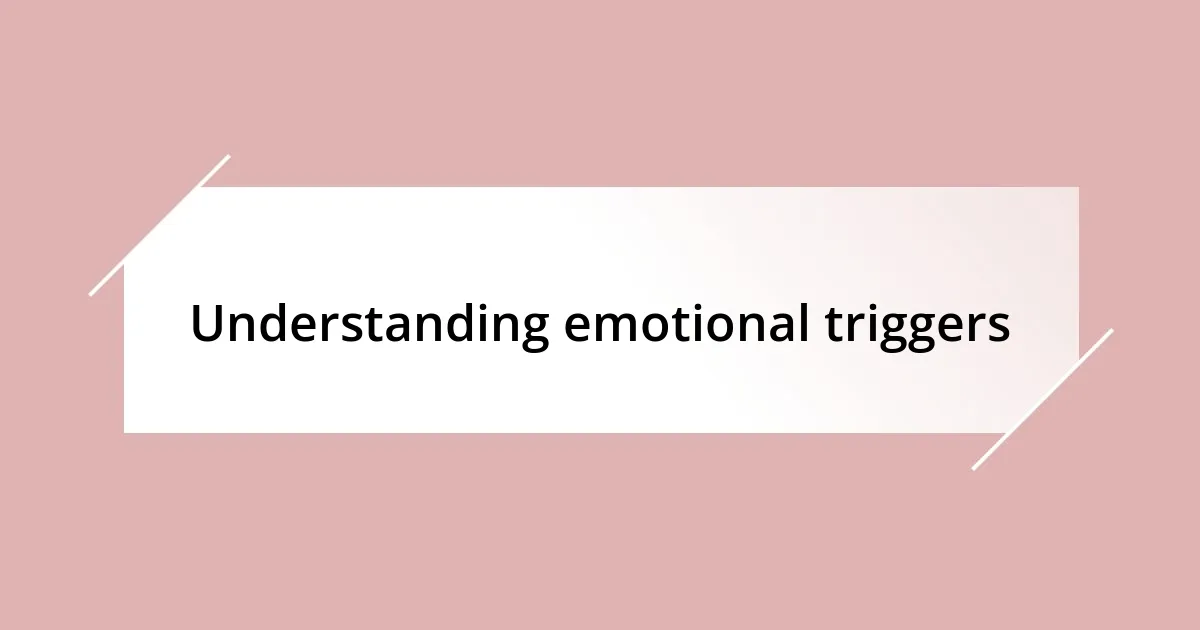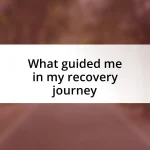Key takeaways:
- Emotional triggers are often linked to unresolved past experiences, and recognizing them can enhance self-awareness and emotional management.
- Practicing mindfulness, journaling, and engaging in physical activity are effective coping mechanisms for managing emotional responses to triggers.
- Creating a supportive environment and fostering open communication with loved ones can significantly improve emotional well-being and resilience against triggers.

Understanding emotional triggers
Emotional triggers are those reactions we experience when something from our environment deeply resonates with past experiences, often without us even realizing it. I remember vividly the first time I felt inexplicably angry during a casual conversation; it caught me off guard. Was it the words spoken, or was it something deeper within me that was stirred?
Recognizing these triggers requires introspection. For instance, one particular smell brought back a flood of childhood memories, leaving me feeling both nostalgic and uneasy. Have you ever noticed how a song can instantly transport you back to a moment in time? That’s the power of triggers—they can evoke emotions as if time has bent around us.
What’s fascinating is how these triggers often reveal our unresolved feelings. I learned that feeling anxious in crowded places stemmed from an old fear of not being heard or valued. It’s interesting to consider: how much of our current emotional landscape is colored by past experiences? Understanding these triggers can be the first step toward managing our emotional responses more effectively.

Identifying your personal triggers
Identifying personal triggers is a journey toward self-awareness. One day, I found myself feeling overwhelmed at a social gathering. At first, I thought it was just the noise, but reflecting deeper, I realized it stemmed from childhood experiences where I often felt out of place. This realization opened up a new understanding of my social anxiety, highlighting the need to explore the roots of my discomfort.
It’s also essential to pay attention to physical reactions. Sometimes, when I’m confronted with certain situations, my heart races or I feel a knot in my stomach. By noting these physiological responses, I’ve been able to trace back to specific triggers tied to past events, helping me respond more mindfully. Keeping a journal of these moments has proved invaluable—documenting reactions helps reveal where deeper issues lie.
When identifying triggers, consider the people and environments you feel most at ease or anxious around. For instance, I once noticed that certain friends would always leave me feeling drained. After some reflection, I realized that their energy was a stark contrast to what I needed in those moments. Understanding these dynamics has been fundamental in shaping my relationships and taking care of my emotional health.
| Type of Trigger | Personal Insight |
|---|---|
| Emotional Triggers | Childhood experiences shape reactions |
| Physical Reactions | Body signals indicate deeper feelings |
| Social Triggers | Dynamics in relationships affect well-being |

Recognizing early warning signs
Recognizing early warning signs has been a significant aspect of my journey in understanding my triggers. There are subtle cues that often pop up before I fully realize I’m entering a triggered state. For instance, I’ve noticed that when I start feeling restless or irritable during a casual discussion, it often signals something deeper is bothering me—perhaps an underlying fear or an unresolved issue lurking in the background. These sensations, almost like alarm bells, remind me to pause and examine what’s truly going on in my mind and body.
Here are some early warning signs I’ve recognized:
- Increased heart rate: I can often feel my heartbeat quicken in response to certain topics.
- Tension in my shoulders: When I catch myself tensing up, I know it’s time to self-reflect.
- Sudden need to withdraw: I sometimes find myself wanting to leave a situation unexpectedly; it’s a sign I need space.
- Irrational anger or sadness: If I experience an emotional outburst over something minor, I realize it’s time to dig deeper into my feelings.
By tuning into these early signs, I’ve gained more control over my emotional responses, allowing me to address the root causes rather than getting swept away by the wave of emotions.

Impact of triggers on behavior
It’s fascinating how triggers can significantly shape our behavior. For example, I remember a time when I was at a coffee shop, and the sound of a coffee grinder sent me into a spiral of anxiety. It made me realize just how connected our past experiences are with our present reactions. Have you ever noticed how a particular sound or smell can throw you back to a moment you thought you had left behind? Understanding these links is key to unraveling why we sometimes respond so intensely.
Triggers don’t just affect our emotional state; they can alter how we interact with others. I once had a friend who would frequently bring up a sensitive topic, and each time, I felt a mix of anger and frustration, even though he meant no harm. I’ve learned that these reactions caused me to shut down or lash out, hurting the relationship without even realizing it. It’s a reminder that our behavior often stems from deeper triggers, and recognizing this can pave the way for healthier communication.
Moreover, I find that my triggers can lead to patterns that can be quite harmful. After a particularly triggering incident at work, I caught myself snapping at colleagues over trivial matters. It dawned on me that these outbursts weren’t just random; they were my mind’s way of coping with stress. Isn’t it enlightening to think about how recognized triggers can act as warning lights for our mental and emotional states? This awareness opens new avenues for managing my reactions and fostering better relationships with those around me.

Healthy coping mechanisms
Healthy coping mechanisms have been instrumental in my journey towards emotional stability. One method I’ve found incredibly effective is mindfulness meditation. When I notice myself getting anxious, I sit in a quiet place and focus on my breath. This simple act often centers my thoughts and gives me a clearer perspective on what triggered those feelings. Have you ever taken a moment just to breathe deeply and felt your worries dissipate?
Another approach that has made a profound difference for me is journaling. I make it a point to write about my experiences and emotions daily. During one particularly challenging week, I poured my heart into my journal and gained clarity on a tension I felt with a close friend. Writing it all out illuminated the misunderstandings I had held, showing me a path to resolution. Isn’t it amazing how putting pen to paper can transform spiraling thoughts into coherent insights?
Additionally, physical activity is a wonderful outlet that I leverage. I often engage in a brisk walk when I sense emotions bubbling beneath the surface. The rhythmic motion not only distracts me but also releases endorphins, stabilizing my mood. Can you recall a time when a little movement lifted your spirits? For me, it turns a chaotic emotional storm into calm, manageable waves.

Practical strategies for managing triggers
One of the most practical strategies I’ve stumbled upon for managing triggers is creating a trigger journal. It’s not just about noting down what upset me, but also reflecting on the circumstances around those moments. I’ve found it surprisingly revealing. For instance, after keeping track of my triggers for a month, I saw a pattern emerge—certain environments consistently led to anxiety. Recognizing this pattern helped me proactively avoid those situations. Have you ever thought about how understanding your triggers could empower you?
Another strategy that’s truly transformed my approach is developing a “pause and breathe” routine. Whenever I feel that familiar rush of frustration, I take a moment to step back. I might close my eyes and count to ten, or simply focus on my breathing. I recall one particularly heated moment at work when a colleague’s comment triggered my defensiveness. Instead of reacting right away, I paused and took a few deep breaths. It made a world of difference! The anger dissipated, and I was able to respond calmly. Isn’t it amazing how a few seconds can change the entire outcome of a situation?
Lastly, surrounding myself with supportive individuals has been crucial. I’ve built a network of friends who understand my triggers and provide that sense of safety. One dark day, I was really struggling with a strong emotional response to a small incident. A friend noticed and reached out, reminding me that it was okay to feel what I felt. They helped ground me, providing a listening ear and wise guidance. It’s comforting to know there are people who can help me navigate through my tough moments. Who do you lean on when triggers surface? Having that support system can be a game-changer.

Creating a supportive environment
Creating a supportive environment has made an immense difference in my emotional well-being. Recently, I realized how crucial it is to curate my space and the people in it. For instance, I painted my room in calming colors and added cozy elements like soft blankets and plants. The moment I stepped into that rejuvenated space, I felt a wave of tranquility washing over me. Have you ever noticed how your surroundings can influence your mood?
In addition to the physical environment, I’ve learned the value of open communication with loved ones. I recall a heart-to-heart conversation with my sister when I was feeling overwhelmed. I shared my triggers, and she responded with empathy and understanding, offering to check in with me regularly. This level of support created a safe haven where I could be vulnerable without fear of judgment. Isn’t it remarkable how just sharing your feelings can reinforce the bonds with those who care?
I’ve also developed a habit of engaging in nurturing activities with friends, which cultivates a sense of belonging and support. One memorable weekend, I organized a small get-together focused on gratitude and positivity. We each shared things we appreciated about ourselves and each other, leaving everyone feeling uplifted. It was a powerful reminder that a supportive community fosters growth and resilience. Do you have similar experiences that highlight the importance of connection? It’s evident to me that when we surround ourselves with positivity, we empower ourselves to face our triggers head-on.












